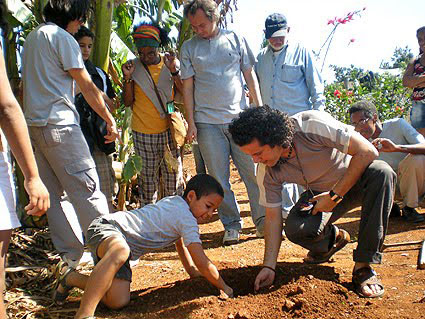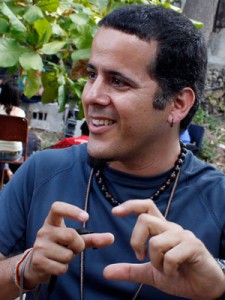In December 2006 a century-old Ceiba tree was cut down in the San Agustín neighborhood of Havana, the Cuban capital. But this was more than a tree. It was the symbol of the city and of the cultural heritage of this Caribbean nation.
This sad event inspired a group of young Cubans to found El Guardabosques (The Guardian of the Forest or Forest Ranger) in January 2007 with the mission to “contribute to a better management of green spaces.”
El Guardabosques reported the death of the Ceiba tree by email to hundreds of recipients, including government institutions.
“The response was incredible,”says Isbel Díaz, founder of the environmental group, “and it prompted us to perform the first action: edit a digital newsletter.” The group now publishes a free digital newsletter “to denounce anti-ecological depredations in the urban environment.”
The members of this project recognize the role of technology and virtual networks in the creation of a community. According to Isbel Díaz, networks allow you to build “your own communication channels to denounce the actions of private or state institutions that violate the law, or that hidden in the lagoons of the law, damage the environment.”
Thus El Guardabosques was born, a non-institutionalized network of people passionate about nature [es]:
A partir de un núcleo inicial de unas cinco personas, todas vecinos de San Agustín, se han ido sumando puntualmente personas y colectivos a este trabajo. Hay quienes han estado solo en la siembra de una postura y nunca más hemos coincidido, y están quienes han participado en casi todo lo que se hace.
The most significant aspect of this project is its focus on inclusion and participative democracy. There are no exclusions based on age, gender, sexual orientation, religious belief, political affiliation or economic status to participate in El Guardabosques.
For over five years, the distribution of the newsletter on the Internet has been complemented with hundreds of actions such as cleaning rivers, oceans and landfills. In addition, community projects have focused on planting and caring for trees.
Currently, El Guardabosques’ newsletter is sent to nearly 1,000 email addresses. Seventy-eight percent belong to residents in Cuba who access the Internet from the internal network, mainly from universities, research institutes, cultural and artistic institutions. The group has also participated in events like the panel “We think Cuba,” which is coordinated by the Hermanos Saiz Association.

Planting of an Anacagüita. Photo: Courtesy of Isbel Díaz
In June 2009, El Guardabosques joined the Red Protagónica Observatorio Crítico [es], a network which includes a dozen projects that work on issues related to childhood, sexual diversity, race, information, cultural promotion, among others. Participants inaugurated their fourth meeting in 2010 by planting an Anacagüita tree in a nursery.
According to the newsletter:
Trabajadoras del centro, encabezadas por su amable directora, niños de la comunidad, miembros de la Red Protagónica Observatorio Crítico, e invitados al evento decidimos colectivamente el mejor sitio para sembrar el arbolito, cavamos el hoyo, y sembramos y regamos la planta.
The death of the Ceiba tree in San Agustín has inspired the creation of a wonderful network of people who support each other and believe in environmental causes. El Guardabosque has also expanded its network of environmentalists and has created a space for exchange with other projects.








4 comments
WHAT INTERNET ACCESS? CUBANS HAVE THE LOWEST INTERNET CONNECTION IN THE WESTERN HEMISPHERE!
REPORTERS WITHOUT BORDERS: INTERNET ENEMIES
According to the authorities, nearly 10% of Cuba’s population is connected to the Internet. That does not necessarily mean that they have access to the World Wide Web. Two parallel networks co-exist on the island: the international network and a closely monitored Cuban intranet consisting only of an encyclopaedia, email addresses ending in “.cu” used by universities and government officials – a sort of “Cuban Wikipedia” – and a few government news websites such as Granma.
The regime does not have the means to set up a systematic filtering system, but it counts on several factors to restrict Internet access: the exorbitant cost of connections – about 1.50 U.S. dollars per hour from the points of access to the state-controlled intranet, 7 U.S. dollars per hour from a hotel to access the international network (even though the average monthly salary is 20 U.S. dollars), and lastly infrastructural problems, particularly slow connections.
These obstacles explain why the number of Internet users and the time spent online remain limited. Most cybernauts try to just read their emails and answer them. They do not have the time to navigate the Internet or surf websites. For years, the regime has been blaming the American embargo for the lack of a good Web connection on the island, claiming that it prevents the country from accessing international networks. That problem is about to be solved, thanks to the ALBA-1 fibre optic undersea cable which has been linking Cuba to Venezuela since February 2011, thereby increasing 3000-fold Cuba’s capacity to connect to the rest of the world. It is scheduled to be put into service in July 2011.
The legal arsenal used against online opposition to the regime remains particularly harsh and dissuasive. Cuban netizens risk punishment of up to twenty years in prison for posting an article deemed “counter-revolutionary” on an Internet website hosted abroad, and five years for illegally connecting to the international network.
http://en.rsf.org/internet-enemie-cuba,39756.html